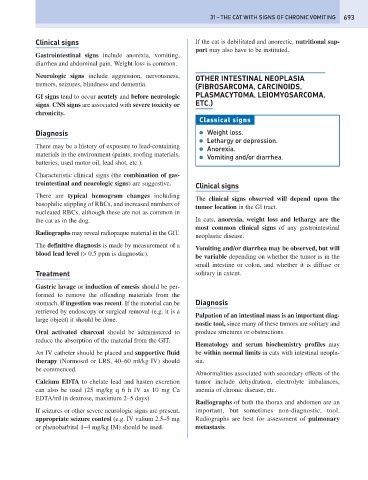Page 701 - Problem-Based Feline Medicine
P. 701
31 – THE CAT WITH SIGNS OF CHRONIC VOMITING 693
Clinical signs If the cat is debilitated and anorectic, nutritional sup-
port may also have to be instituted.
Gastrointestinal signs include anorexia, vomiting,
diarrhea and abdominal pain. Weight loss is common.
Neurologic signs include aggression, nervousness,
OTHER INTESTINAL NEOPLASIA
tremors, seizures, blindness and dementia.
(FIBROSARCOMA, CARCINOIDS,
GI signs tend to occur acutely and before neurologic PLASMACYTOMA, LEIOMYOSARCOMA,
signs. CNS signs are associated with severe toxicity or ETC.)
chronicity.
Classical signs
Diagnosis ● Weight loss.
● Lethargy or depression.
There may be a history of exposure to lead-containing
● Anorexia.
materials in the environment (paints, roofing materials,
● Vomiting and/or diarrhea.
batteries, used motor oil, lead shot, etc.).
Characteristic clinical signs (the combination of gas-
trointestinal and neurologic signs) are suggestive.
Clinical signs
There are typical hemogram changes including
The clinical signs observed will depend upon the
basophilic stippling of RBCs, and increased numbers of
tumor location in the GI tract.
nucleated RBCs, although these are not as common in
the cat as in the dog. In cats, anorexia, weight loss and lethargy are the
most common clinical signs of any gastrointestinal
Radiographs may reveal radiopaque material in the GIT.
neoplastic disease.
The definitive diagnosis is made by measurement of a
Vomiting and/or diarrhea may be observed, but will
blood lead level (> 0.5 ppm is diagnostic).
be variable depending on whether the tumor is in the
small intestine or colon, and whether it is diffuse or
Treatment solitary in extent.
Gastric lavage or induction of emesis should be per-
formed to remove the offending materials from the
stomach, if ingestion was recent. If the material can be Diagnosis
retrieved by endoscopy or surgical removal (e.g. it is a
Palpation of an intestinal mass is an important diag-
large object) it should be done.
nostic tool, since many of these tumors are solitary and
Oral activated charcoal should be administered to produce strictures or obstructions.
reduce the absorption of the material from the GIT.
Hematology and serum biochemistry profiles may
An IV catheter should be placed and supportive fluid be within normal limits in cats with intestinal neopla-
therapy (Normosol or LRS, 40–60 ml/kg IV) should sia.
be commenced.
Abnormalities associated with secondary effects of the
Calcium EDTA to chelate lead and hasten excretion tumor include dehydration, electrolyte imbalances,
can also be used (25 mg/kg q 6 h IV as 10 mg Ca anemia of chronic disease, etc.
EDTA/ml in dextrose, maximum 2–5 days).
Radiographs of both the thorax and abdomen are an
If seizures or other severe neurologic signs are present, important, but sometimes non-diagnostic, tool.
appropriate seizure control (e.g. IV valium 2.5–5 mg Radiographs are best for assessment of pulmonary
or phenobarbital 1–4 mg/kg IM) should be used. metastasis.

